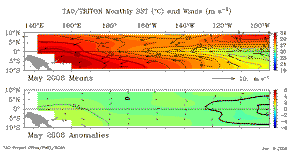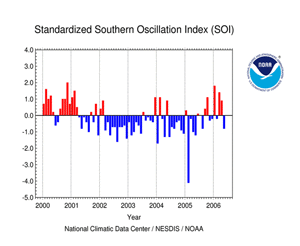NEUTRAL ENSO CONDITIONS DEVELOP
ACROSS THE EQUATORIAL PACIFIC
ACROSS THE EQUATORIAL PACIFIC
|
|
Sea-Surface
Temperatures (SSTs) and
Mixed-Layer Conditions: SSTs increased across most of the equatorial Pacific Ocean this past month. The observed SST anomalies during May were close to average in the western and central parts of the tropical Pacific basin. In the mixed-layer, water temperatures were near-normal to slightly above normal in the western and central Pacific, while warm anomalies developed near the South American coast. For the month, the SST anomaly in the Niño 3.4 Index region was +0.13°C (+0.23°F). The SSTs in the Niño 4 Index region of the western equatorial Pacific were +0.16°C (+0.29°F) above the mean (map of Niño regions). For the most recent global ocean surface temperatures, please see the loop of satellite-derived weekly SST anomalies for May 2006. Below average SST anomalies persisted throughout the latter half of 2005 and into the first few months of 2006 in the central equatorial Pacific basin, and this can be seen in the data from NCDC's Extended Reconstructed Sea Surface Temperature dataset (ERSST version 2). Due to the recent warming of SSTs in the central tropical Pacific, the 3-month running mean of the Niño 3.4 index region increased above -0.5°C in April, and continued to warm to near-average in May. (NOTE: For NOAA's official ENSO classification scheme, please see NOAA's El Niño/La Niña Index Definition and also see the CPC ENSO Diagnostic Discussion for NOAA's latest official assessment of ENSO conditions.) |
|
|
Equatorial Zonal Winds (U-Component
Winds) and Sea-Level Topography: The easterly trade winds were slightly below-normal across the central and western equatorial Pacific basin during May. Stronger than average easterly winds were observed in the eastern equatorial Pacific, where the trade winds were above average during the month. The most recent Pacific overpass of the NASA/JPL Jason-1 satellite observed several areas with large positive sea level anomalies in the southwest and northwest equatorial Pacific, most likely associated with enhanced tropical convection in these areas. Sea levels were mostly near-average throughout the equatorial Pacific during May, as the sea level heights reflected the near-normal SST conditions at the end of the month (see the 30 May 2006 overpass). |
|
|
Outgoing
Longwave Radiation (OLR): The map to the left shows the spatial pattern of global OLR (in W m-2) observed by satellite during May. Positive OLR anomalies (typically associated with La Niña) have persisted over the past several months primarily in the equatorial western Pacific region, centered near the Date Line, and tropical convection was again suppressed along the equator in the central and eastern Pacific this past month. The 3-month averaged OLR anomalies were also positive in the western Pacific basin and along the equator, reflecting the reduced cloudiness during the 2005/2006 cold event. The monthly-averaged OLR Index was positive during May, but remained only slightly above neutral with a value of +0.9 W m-2 for the month, averaged across an area centered over the Date Line in the western Pacific between 160° E and 160° W (note that positive OLR Index values are typically associated with La Niña conditions in this region). May was the tenth consecutive month with a positive OLR Index. Note that high frequency variability in OLR is typically associated with the Madden-Julian Oscillation (MJO, which is convective activity that propagates west to east in the near-equatorial region from the Indian Ocean into the Pacific Ocean approximately every 30-60 days). The latest MJO activity can be seen in CPC's graphs of Daily MJO Indices. |
| Southern Oscillation Index
(SOI): The standardized SOI switched signs to a negative value in May, with an average value of -0.8 for the month. The SOI was inconsistent during the relatively weak 2005/2006 La Niña, fluctuating several times between a near-neutral value and both positive and negative indices. The recent shift to a negative value in May coincided with the development of warmer than average SSTs in the equatorial Pacific. |
Additional Links
- ENSO Monitoring
- NOAA El Niño / La Niña Index Definition
- NOAA's Pacific Marine Environmental Laboratory (PMEL):
- NOAA's Climate Prediction Center (CPC):
- NOAA's Physical Science Laboratory
- NASA/JPL Ocean Surface Topography from Space
- Australian Bureau of Meteorology (BoM) Climate Driver Update
- IRI - International Research Institute
 NOAA's National Centers for Environmental Information
NOAA's National Centers for Environmental Information





 Larger image of
May OLR
Larger image of
May OLR Larger image
of March-May OLR
Larger image
of March-May OLR Larger image of May
OLR Index
Larger image of May
OLR Index